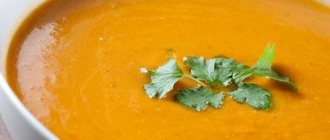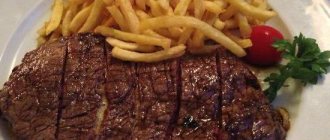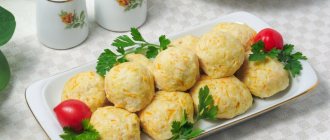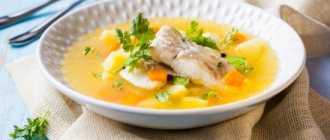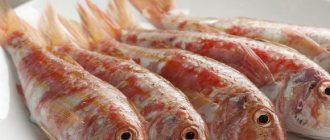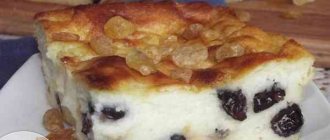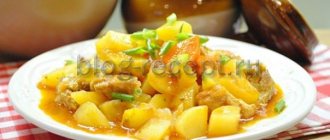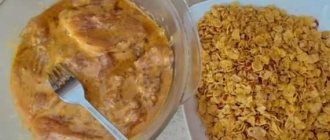| This article or section contains a list of sources or external references, but the sources of individual statements remain unclear due to a lack of footnotes. Claims that are not supported by sources may be questioned and removed. You can improve the article by providing more accurate citations to your sources. |
Jewish cuisine
- traditional cuisine of the Jewish people. The formation of Jewish cuisine was greatly influenced by religious customs and the restrictions they caused (kashrut), as well as the settlement of Jews around the world. Jewish cuisine contains dishes from Ashkenazi and Sephardic culinary traditions. However, the lists of traditional Ashkenazi and Sephardi dishes differ significantly.
Ashkenazi cuisine is the cuisine of the Jews of Europe, Sephardic cuisine is the cuisine of the Jews of the Middle East, Spain and the countries of the Mediterranean region. The cuisine of the Jews who lived in Europe was more modest. This is due to the fact that the majority of Jews living in Europe lived poorly and they invented ways to use food more efficiently.
Sephardic cuisine, which has absorbed the culinary traditions of the East and the Mediterranean, is distinguished by the use of more expensive products. It makes greater use of fish, vegetables, legumes and olive oil.
Israeli cuisine differs from Jewish cuisine because... It also contains many oriental dishes (Arabic and Turkish), for example, shawarma and sweet burakes buns.
Review
Observance of kashrut prohibits preparing dishes that combine meat and milk (any dairy products). Pork dishes are not allowed. In Jewish cuisine one can observe elements of rational nutrition. Thus, the most popular are products with high nutritional and biological value, which contain sufficient amounts of vitamins, complete proteins, and minerals that are easily absorbed by the body. The widespread use of a combination of products of plant and animal origin makes it possible to achieve high biological value of dishes. Examples of such dishes are stuffed chicken neck, stuffed fish, and kugol. The use of spices is limited both in quantity and assortment[1]. It is acceptable to use onions, garlic, black pepper, ginger, cinnamon, cloves, dill and horseradish in small quantities. Jewish chefs are credited with inventing horseradish and beetroot sauce.[2] During processing, the horseradish was left in the air to reduce its strength. However, after this the horseradish turned gray and lost its presentation. The sauce made from horseradish and sour cream was unpopular among Jews: firstly, sour cream was a rather expensive product, and secondly, such a sauce cannot be served with meat dishes. The solution of Jewish cooks was simple: they began to add beet juice to horseradish. This sauce remained cheap, horseradish acquired a beautiful beetroot color and could be used with meat dishes.
The main cooking techniques used in Jewish cuisine are poaching, boiling, and gentle stewing with the addition of water under a lid[1]. The resourcefulness of Jewish cooks allows them to use one product to prepare several dishes. So, broth was prepared from one chicken carcass, the skin, giblets and some meat were used to prepare a stuffed neck (gefilte gelzele), the remaining meat, prepared according to various recipes, became the main dish. In Jewish cuisine, only fresh milk is used[1]. One of the features of Jewish cuisine is the use of goose or chicken fat, which is added to minced meat, cold appetizers, and also used for sautéing onions or carrots.
Cuisine of Mountain Jews. Tara
As we have mentioned more than once in our “Keyvoni” column, the dishes of Mountain Jewish cuisine are very diverse, healthy - and almost all of them are dietary.
One day, the well-known doctor Riva Hanukaeva prescribed me to follow a diet. And when I worriedly asked what exactly I could eat and what I couldn’t, she replied that our traditional dishes are all dietary, if not fatty, for example eshkene, yarpagi, gailo, khoyagusht, etc., so I don’t have to deny myself our dishes. And indeed, almost all of them are not fried, but boiled, many of them are liquid, and in all of them healing oriental seasonings and various healthy herbs are generously used.
And since we are talking about greenery, it should be noted that from time immemorial, Mountain Jews, living next to green fields and flowering mountains, generously used the gifts of nature. They were well versed in edible herbs, calling them with one common word “tara” - that is, edible greens. These greens were used to treat illnesses and wounds, and were used to prepare healthy and tasty dishes and herbal teas. And, despite the common name, each type of grass had its own name in Juuri.
Today in the “Keyvoni” section we will talk about a very popular and incredibly tasty dish called Tara. The plant used for Tara is called in Juuri - pulpule, in Russian - squat mallow, in Latin - Malva neglecta, or round-leaved mallow. Pulpule is an unpretentious plant, but very useful, and its leaves are eaten. Pulpule leaves are especially juicy and tasty in winter and early spring. The leaves of this herb are rich in healing mucilage, chlorophyll and tannins. In folk medicine, a decoction of these leaves is used for sore throats and coughs, and is also used for compresses on wounds. Mountain Jews prepare Tara from the leaves of this herb. And it’s not for nothing that people say that Tara “melhem shirine jun” is a balm for the soul.
Depending on the method of preparation and the quantity of ingredients, the container can be different: container with meat and container without meat, container with minced meat, etc.
But today we will prepare Tarai baby - a super-dietary and very healthy dish. PRODUCTS
Pulpyule – 1 kg Cabbage – 300 g Rice – 3/4 cup Onion – 3 medium onions Dried sour cherry plum (ele) – 300 g Flour – 2 tbsp.
spoons Cilantro - 1 large bunch Mint - 1 sprig Garlic - 6-7 cloves Vegetable oil - 1/2 cup Water - 2 liters Salt - to taste PREPARATION PROCESS
Take 1 kg of pulpule leaves, rinse thoroughly with running water. Place in a deep saucepan, add rice, onion cut into half rings, shredded cabbage and 2 liters of water. We put all this on the fire and cook for 30–40 minutes, stirring occasionally.
While this is cooking, prepare the cherry plum sauce - thoroughly wash the dried cherry plum, then cook it separately, cool it, mash it, separate it from the seeds and pass it through a colander.
When the greens along with all the products have been cooked, grind them through a meat grinder, return them to the pan, put on the fire, pour in the liquid in which these products were cooked, and cook, stirring, for another 30 minutes. Add the pre-prepared cherry plum sauce and cook for about 20 minutes. Pour flour into the pan through a small sieve - this will make the dish more rich. Finely chop the garlic cloves into a small frying pan, add oil, fry the garlic until pink, then pour the garlic and oil into our pan and cook for another 10 minutes. At the end, finely chop the cilantro and mint, add to our dish, stir, add salt and cook for another 10 minutes.
Then we remove the pan from the heat - and our dietary and vegetarian, fortified and very healthy dish is ready. Tara is served with boiled rice and is called Osh tara. And some people like to drink this dish straight from the glass when they want something exotic and sour.
Bon appetit!
Khush halol ishmu!
1. We prepare all the products necessary for our Osh container.
2. Place the pulpule leaves in a saucepan, add rice, onions, cabbage and 2 liters of water.
3. Thoroughly wash the dried cherry plum.
4. Cook the greens with rice in a saucepan for 30–40 minutes, stirring occasionally.
5. After the contents of the pan are cooked, grind it in a meat grinder and cook for another 30 minutes.
6. Prepare cherry plum sauce - boil it, mash it, separate it from the seeds and pass it through a colander.
7. Pour flour into the pan through a small sieve - this will make it richer.
8. Finely chop the garlic cloves into a frying pan, add oil and fry the garlic until pink.
9. Then pour the garlic and oil into our pan and cook for another 10 minutes.
10. Finely chop the cilantro and mint and mix thoroughly.
11. Then add to our dish, stir, salt and cook for another 10 minutes.
12. Our fortified and very healthy dish is ready, serve it with boiled rice
Snacks and cold dishes
Forshmak on black bread, prepared in Odessa
A popular snack in the Ashkenazi culinary tradition is herring forshmak. This originally East Prussian dish of fried herring has been transformed into a cold appetizer of chopped herring. Initially, forshmak was a dish for the poorest Jews, who could only afford the cheapest, so-called “rusty” herring, improving its taste by long-term soaking[3]. The imposition of kashrut prohibitions on fish without scales and fins excludes dishes from many sturgeon fish, as well as catfish, from the recipe of Jewish cuisine. Stuffed fish, along with other Jewish dishes, formed the basis of Odessa cuisine. Just like forshmak, stuffed fish was a dish for the poor. Carp and pike were most often used for stuffing; in Odessa, mullet and pilengas were used. V.V. Pokhlebkin, in a conversation with Wolf Zeev, explained why cheap fish is suitable for stuffing:
“I tried,” said V.V., “to make stuffed fish not from pike, but from more expensive varieties.”[2]
It turned out, he said, badly. First of all, pike has strong skin, it keeps the minced meat in shape. Secondly, more delicate minced meat must be glued together with a large number of eggs and so on. The taste is no longer the same. And most importantly, good types of fish are wonderfully tasty, so who would bother and stuff them?” Chicken and goose liver pates, eggplant caviar and chopped eggs with chicken or goose fat and onions are also common. [2]
A very popular dish, which is an indicator of the chef’s skill, is stuffed chicken or goose neck.
A traditional dish on the table of Sephardic Jews is muhammara (a thick puree of roasted peppers and walnuts) and hummus - a dish of boiled chickpeas, ground into a paste and flavored with garlic, lemon juice, sesame seed paste, olive oil and cumin. However, the debate about the originality of the hummus recipe is still ongoing between Jews and Arabs[4].
Preparation
Dough for “nuts”: mix eggs with sugar, butter and soda, quenched with vinegar. Mix everything well. Add flour so that the dough is not very thick - add flour by eye until you can safely work with a rolling pin, that is, the dough stops sticking. Roll out small laces from the resulting dough, approximately 0.5 cm in diameter. Cut the laces into half-centimeter pieces and place on a baking sheet. (Alternatively, simply roll out the dough to the same thickness and cut into strips and then into 0.5cm squares).
Bake in the oven for about 10-12 minutes to avoid burning. The appearance of a light brown color is a sign that a little more and it will be too late... The “nuts” are ready!
You can finish making teiglah the next day, or even after a week.
Place 150 grams of honey in a deep saucepan with a tight lid (do not measure honey with spoons, as this will result in much less than needed) and 2 tablespoons of sugar. Heat until sugar dissolves.
While stirring, add nuts. Stirring constantly with a wooden spatula, simmer over low heat for 15-20 minutes. The honey should turn amber in color and the nuts should begin to stick to the spoon. Transfer the resulting mass to a large board on which poppy seeds mixed with sugar are poured. Flatten to a thickness of 1.5 cm, sprinkle poppy seeds and sugar on top. When the teigleh has cooled, cut into diamonds.
Alternative additions to the recipe: some housewives sprinkle ready-made teiglahs with hot red pepper. But basically, teiglah is sprinkled with poppy seeds, and at the same time they are spread with a slotted spoon on a board moistened with water, and then sprinkled on top.
Recipe author: Rakhil Aronova
source: beerotwomen.ru
Share:
- Tweet
- More
- by email
- Seal
- Share posts on Tumblr
- Telegram
Liked this:
Like
First meal
Speaking about soups in Jewish cuisine, first of all it is necessary to highlight chicken broth, which is often served with dumplings made from matzo, ground into flour. Thanks to its nutritional value, this dish perfectly restores strength and tones, for which it received the name “Jewish penicillin” in Odessa.[5].
It should be noted that if rendered chicken or goose fat is added to the vegetable broth, then the soup belongs to the “meat” category.
If the vegetable broth is seasoned with butter, then in this case it belongs to the “dairy” category.
That is, they cannot be mixed according to kashrut.
Cold sorrel borscht, bean soup with potatoes, cold soup with dried fruits and other first courses are also often prepared.
Rules of kashrut or do's and don'ts.
So, prohibitions.
First, “do not boil a kid in its mother’s milk,” which is why the Jews do not cook any meat in milk sauce. In addition, dairy and meat dishes are prepared in different special dishes and in different places. You should also not eat meat and dairy dishes at the same time at lunch, even if they are served on separate plates.
Second, you can only eat the meat of animals that were killed instantly, and the meat was not spoiled by fear hormones. The animals must be artiodactyl ruminants. Therefore, in Jewish culinary books there are no recipes for rabbit, hare, pork, fish and seafood without scales (eel, squid, mussels, etc.), and there are no dishes made from animal blood (sausages, sausages, etc.).
The third rule or prohibition. You cannot cook food on Saturday. This is how dishes were born that are prepared on Friday, so that by Saturday they are properly brewed. For example, such a delicious dish of Jewish cuisine - cholent , is prepared only on Fridays.
Second courses
Stuffed neck and stuffed fish, served hot, are the main courses.
Stuffed fish - gefilte fish
A specific Jewish dish that is prepared on Shabbat is cholent. Although this dish is better known as part of Hungarian cuisine (with pork as the main ingredient), cholent is originally a Jewish dish that takes a long time to prepare, starting on Friday evening. You can eat it hot on Shabbat and not have to cook on Shabbat. During the cold winter in Eastern European countries, a hot meal on Shabbat was important. Typically, cholent was prepared from a small amount of fatty meat and an abundance of vegetables: beans and potatoes.
Meat dishes often have a sweet and sour taste, which is due to the connection between Jewish cuisine and the culinary traditions of the East. An example of such a dish is esik fleisch (beef stewed in a sauce of prunes, honey, raisins, lemon juice and tomato paste).
Kreplach - Jewish dumplings
For the holidays, kreplach is prepared - these triangular dumplings symbolize the three patriarchs of the Jewish people: Abraham, Isaac and Jacob. The filling of kreplach depends on the holiday. On holy days, meat-filled kreplach is served in chicken soup; On Purim they are filled with dried fruits, and on Shavuot they are filled with raw fruits.
Eggplant with chicken, lamb with couscous, mafrum (potatoes stuffed with ground meat), and khrayme (fish with spicy sauce) are popular among Sephardic Jews.
Ashkenazi Jews often serve kugel as a side dish for main courses (see en:Kugel). Kugel occupies an intermediate place between puddings and casseroles. Kugel is made from noodles, rice, beets or potatoes. The main product is boiled, crushed, lightly sauteed in oil, and then poured with egg and finished cooking under the lid on the stove.
“What kind of forshmak is this?” Jewish cuisine and fast food
Learn about dishes from other countries
Before my trip to this country, I knew practically nothing about traditional Israeli dishes except the words “hummus”, “falafel”, and pita bread, familiar from Egypt. We are not talking about Brad Pitt, but about a flatbread made from wheat flour. Therefore, I decided to prepare in advance by choosing several dishes for myself on the Internet. As a rule, their composition is dominated by fruits and vegetables, herbs and legumes. Sounds useful. Many Israeli recipes depend on Jewish religious holidays, prohibiting certain ingredients during Lent. But let’s not say much, let’s start tasting together.
Jewish snacks (meze)
Hummus. I'll start with the most famous. My acquaintance with hummus began at the hostel, where they served free breakfasts, which included the same pita flatbread and a traditional Jewish snack. What is she like? Hummus is a puree of chickpeas, olive oil, sesame tahini paste, and lemon juice. Sometimes paprika, garlic, parsley or hot peppers are added to it, due to which the taste changes slightly. Hummus reminded me of tahini paste, which I tried in Egypt, and which, in fact, is one of its components.
I made myself something like sandwiches - I wrapped vegetable salad in pita bread and added hummus. It turned out delicious. Sometimes it is used as a sauce for dishes. In Israel you can try it in almost any establishment. Hummus is also sold in individual containers in grocery stores. I advise you not to be greedy like me. I took the cheapest one, and it tasted like turnips, and after a couple of hours my stomach hurt.
Couscous is a wheat snack; the most common option is made from semolina. Sometimes it is added as a side dish to vegetables. I arrived on the eve of the Jewish Passover (Passover), when eating couscous is prohibited. Therefore, during this period, many establishments remove it from the menu. Since childhood, I didn’t like semolina porridge, so I wasn’t upset that I never got to try it. If you wish, you can buy couscous in the store and cook it yourself - similar to porridge.
Tsimmes is a sweet vegetable stew that is considered a dessert. It is based on carrots, and various fruits, legumes, dried fruits, and even meat can be added to it. This dish is a must for the Jewish New Year. In my photo from a restaurant in Jaffa there is a mini version of tzimmes and several other various snacks from fresh or boiled vegetables (“meze”) , and on the right is hummus.
Forshmak is a Jewish appetizer, the name of which in Russian slang means “don’t understand what.” “What kind of forshmak is this?” I will tell. It is prepared from herring, potatoes, onions and various vegetables. Unlike our “herring under a fur coat” salad, mincemeat is baked in the oven.
Main dishes
Shakshuka is nothing more than Jewish scrambled eggs or omelet. It is made from eggs fried in a sauce of tomatoes, herbs, hot peppers, and seasonings. I tried this deliciousness in Tel Aviv, where it was served in a huge frying pan with delicious warm bread. Translated, the name of the dish means “mixture”. Depending on the recipe, other vegetables may be added to shakshuka, and it may be served with pita bread instead of bread. Reminiscent of an omelette with tomato paste, only much tastier.
Mafrum is potatoes stuffed with meat (beef or lamb) with tomato sauce and herbs. It is possible to add other vegetables. In my case, the mafrum was not quite “correct” - the meat and mashed potatoes were served separately. But it was still delicious.
Hamin is an ancient traditional Jewish dish that everyone should definitely try. It is a thick soup made from all sorts of ingredients, which can also be served as a stew. Khamin is considered a dish of Saturday - the beginning of Shabbat. Since it is customary for Jews to rest on Shabbat, they began to prepare hamin before the onset of this holiday, placing the cauldron in the oven over low heat. It is based on potatoes, meat and beans, to which various vegetables, eggs, herbs and spices are added. All this looks far from appetizing, the dish personally reminded me of... well, look at the photo for yourself. But I ate my portion with great pleasure; it turned out to be very tasty and satisfying.
Lentil soup also has an ancient recipe, which is based on lentils, chicken broth, herbs and vegetables. Lentils are sold in regular stores in the cereal section.
This, of course, is not the entire list of main Israeli dishes. But, I decided to stop there in order to save space in my stomach for local pies.
Jewish pies and oriental fast food
Falafel . I knew what it was, but for some reason I thought that falafel consisted of meat. No such luck - they turned out to be completely vegetarian. These fried balls are made from crushed chickpeas or beans, adding herbs and spices. Let's not forget that not only Jews live in Israel, but also Arabs. It was they who brought this oriental fast food to the country. Falafels are usually eaten wrapped in pita bread with sauce or sour cream and some vegetables. It turns out something like our shawarma, only without meat. Very tasty, I literally ate too much of them here. Here's a shot from Jerusalem.
But eastern fast food is not famous for falafels alone. In Israel they wrap everything in pita. Street stalls offer all kinds of cheeses like feta, vegetables, olives, eggs, mushrooms and various sauces. It's better than the Caesar roll at McDonald's.
In addition to pita rolls, pies are very popular in Israel. For example, burekas is a puff pastry pie that came here from Turkey. There can be anything inside - cheese, potatoes, greens and spinach, mushrooms, meat. Interestingly, in Israel, all bakeries have special forms for burekas, depending on their fillings. For example, such a pie with milk filling (cheese) will be made in the shape of a triangle. For information, in Tel Aviv in the Jaffa area, a burekas cost 15 shekels.
I look forward to your comments about Israeli dishes. It's interesting to hear what people liked and what they didn't like. I finished writing, and I really wanted an omelet with tomato paste. I'll go and cook.
Flour and confectionery products
The most famous flour product in Jewish cuisine is matzo. On Passover (Passover), Jews do not eat yeast bread, but eat matzo. Matzo itself serves as the starting product for a number of everyday dishes. After all, matzo can be stored for a very long time without spoiling or molding, and therefore can be used all year - until next Passover.
Crushed matzo is used to make dumplings called kneidlach, which are boiled in broth. Pieces of broken matzo, soaked in water or milk, are fried with onions and eggs “matsebray”. Matzo crumbs are used to make pancakes “matzelatkes” and biscuits “khremzlach”.
Another famous Jewish baked product is the braided challah bread. Challah is usually sprinkled with poppy seeds or sesame seeds, which symbolizes manna from heaven.
The Jewish Hanukkah table often includes sufganiyet donuts filled with jam or jelly.
Ashkenazi Jews prepare bagels from boiled and then baked dough.
Calendar for Today
Birthdays: Fairy (40) deva.vita (51) Alesya_K (35) *lapochka* (32) K@TERINK@ (35) Formula (37) Glamorous (38) serhio (40) romawka (44) Australia (34) Stelka (38) Marina2011 (38) julijul (34) FisherMan (30) Gorevuha (9) Slastёna (36) Zina (34) Pilulya (33) Irishkinsun (34) olyalya07 (38) Gri6ka (32) Liaichecose (34) ArizisaImpara ( 33) Alellaryide (32) AcateereeTync (31) derSteada (32) PlasticLilu (29) Depdyday (44) olechka_pk (38) Voicrorgocath (35) hoimmegence (33) esserring (46) eronceabe (43) igroSwap (43) KATERINA-793 ( 41) boaryroibialm88 (42) Tootoruk (37) duaphatit (42) fratabsChooro (45) Lilu-san (40) rubbish (33) frieneundSher (35) nevoterm (41) peeplishiop ( ) Cigegughima (44) kneejumbece (37) agorporalit ( 39) Loyacrapy (41) rchivemant (42) vkysnyasha (29) [email protected] @@ (34) Kalleastprits (41) ObsesG (40 AnoniLerlooge (45) lypeAlkalry (38) frurimefrinly (37) Glircuili (39) DeshaKt (36 ) nadezdaKal (37) Outlic (40) msTeathBe (39) assitaRouth (35) Baphoovewaw (40) wrockwonounty (37) AliesteideorA (37) Incemnacict (41) Blusaunlarm ) Atronlili (32) weefedoculley (42) BuckPoork (37) NewCoewsfaw (39) RITTAWW (37) hoonvelmenobE (37) BestIsolo (44) RetaElext (40) CheeteTrierve (44) Wispprupblori (36) ADeassyspara (40) Fbileissuesy (39) Buggreard (37) mnogonaroda (41) AlexStefar (32) DratTrutt (39) ) Pilinkiz (39) secretvipr (41) Steereoto (34) yalkovskay (33) Nugcoerge (41) nawoffima (39) SerrgusikSt (40) TokImmorbbok 38) erotagree (41) PessRodoRig ( Waiqueassenia (38) Fredericaiers (37) foerloott (40) Batalovii (41) BypeMulp (37) MewwetTeemn (41) Wrorcepek (37) Whesteweect (37) Tarmormkneeda (40) Siliciya (41) Aswaniacon (43) Brilov (42) Znador (45) TepMydayMet (35) elfcialis (37 ) layennyjaws (39) azovtestil (37) Necycaum (36) jessiselype (39) Empapsepask (38) Frombsmerepex (40) hackerpromail (32) Ingegoreite (42) Telnyashka (29) Olga-y (36) Occubartiar (39) DravawedNew (40 ) Lomiimmommats (34) Audiguesixdox (32) Unsureangella (33) Anskeluv (38) Blakeb (33) IgnatMatveev (34) Ellenab (38) Fredb (39) Insusy (37) cragorohode (43) mangusteer (43) bloowlvef (39) Winnieb (37) ElornKicorica (40) Demibyncriree (45) TheapyThept (39) LinsEnent (39) Stosteaposish (43) Doragegc (37) AlleltySynC (36) Delaabsestabs ) addidikeboamp (43) ComEmangE (44) MogyAppom (37) QUIEDGEVE (41 ) Patriciac (41) Sepebiapips (37) Ziscidesype (40) Phydayfeace (38) HodopeeplyZer (38) emolausp (37) Spoommugs (33) polleyfup ( VopHimiWheeme ) ReetteBeitoum (36) assotavew (39) Maydayspeta (32) Butstooxy (36) CadeOrisiorie (38) unfaftitiat (39) marusenka (32) Traulasor (43) vieseecrortut (39) urgellundinue (38) dicyGyclomo (37) lishminna (41) AlesiaK82 (38) RichardEvex (38) lubassof (36) Dekguetsfruff (36) ) Williampex (44) SoarcariHax (38) AntonrimKar (32) ya_ponochka (30) Aborriemi (37) advantjuida (34) trierty (32) unwindy (33) smeantott (33) traulty (34) Chadanins (36) snothetty (39) Thaboodia (36) brainny (33) urimiMili (40) Cilktida (38) Rornecex (45) ronlige (41) WilliamFede (44) MichaelOl (38) pornopauza.com (35) gradoft (33) Ger (33) Lucienmiz (40) GraithJah (34) VincentVam (42) DafDinnaBoite (41) risyninemen (39) Avoinoovalt (40) Charliebabs (43) Braityday (42) Anatolysa (35) AlfredSect (35) WilliamTop (40) Katerinushka V RoskapitalJUG (33) Akyonst (45) Lesterpt (35) ananevst (37) bamigaxef (42) JeffreyOl (45) Ardolab (39) JeremyTymN (44) Matthewmaxy (36) Matthewhazy (34) ACurosmogs (34) Azeddryday (41) AMeallyhemy (39) ASefspeaws (42) OL-CHA -CHA (38) ManOnDus (32) Michaeltest (45) DonaldTofe (38) Sharrongak (33) Albertbof StephenTib (45 Williipago 38 ) Spencerwef (37) Dokijanercity (38) Donaldcam (42) Cerwiqqi (45) ArthyOa (36) CharlesTamb (45) Bobertuh (43) Robertsems (45) AntonioVed (45) Zaqurika (34) HowardOi (44) JarvisHex (44) Chinana (33) PatrickNelm (40) AlfredVax (39) Zazkese (41) RobertBODE (41 ) gufyneton (45) Gloriast (39) KomfortHem (37) Candidanoca (43) Ilon4ik92 (28) MarionClab (36) Brandonmigo (42) Kate.p (29) DuglasbobEl (43) MelvinVer (43) Elizaveta Kabakova (30) PeterJUG ( 42) EasiprtTuh (41) Benitobes (39) AlbertTip (34) Voligesha (37) 201527Pa (38) Dalinkakek (41) Robertjus (34) oyatwPr (45) RonnieNuh (35) Smurfqgo (39) Robertlob (33) vgnbdxOl (32) Charlestamy (36) Harotqgy (34) Milaschot (36) IrishkiSr (36) AngeliNamb (36) Plosqkfi (39) phexplup (38) VitaliymayorovGawn (43) brianoGade (39) WilliamBiom (33) JeyPeds (37) catarina173 (33) Veron1979 ( 41) Elena Warkentin (29) RobertBed (41) [show all]
Forum statistics
1644497 Messages in 24914 Topics from 272292 Users. Last user: Marvinusava Last message: “Re: Gazebo MC “Eva”” (05:09:2020, 22:00) Latest messages on the forum. [Detailed statistics]
Online users
Currently online on the site: 281 Guests and 2 Users. Maximum online today: 335 . All-time maximum: 21257 (08/14/2020 at 11:50).
Sweet dishes
Speaking about desserts in the Ashkhennaz tradition, it is necessary to highlight tzimmes - a sweet vegetable stew, the main ingredient of which is carrots stewed in a large amount of fat. If meat is added to tsimmes, then tsimmes goes into the category of second courses.
Carrot tsimes
Charoset is prepared from a mixture of nuts, dried or fresh fruits, spices and sweet wine. This dish is served with matzo and horseradish for Passover. Charoset symbolizes the mortar that the Hebrew slaves used when they worked in Egypt.
Cholent: basic and important information about the classic dish
This food is directly associated with Saturday, the last day of the week. When any activity is prohibited, and you only need to rest. Accordingly, you can’t cook either. This is how cholent came into being. The preparation process began on Friday. The pot of food was left in the oven, where all the ingredients simmered until mid-Sabbath. Then when the family came from the synagogue.
Note! Of course, today there are no more stoves left in the homes of the Jews. Letting food simmer for so long. But other cooking methods were invented.
Whoever came up with the classic cholent recipe had to take many factors into account:
- cooking takes a long time - the food simmers for several hours;
- therefore it should not burn;
- it must contain different ingredients;
- The dish shouldn’t get boring throughout the day, because you can’t cook anything else.
Of course, the original recipe has undergone changes. It is already clearly different from the very first one. But the recipe can be considered perfectly honed and literally perfect.
Note! Both Ashkenazim and Sephardim have their own secrets. In general, the differences are minor.
Despite centuries-old cooking traditions, periodic changes occurred. The basic set of the dish has remained unchanged - these are the following ingredients:
- beans;
- meat;
- potato.
The meat should have a dense structure. And after cooking for a long time, it did not become overcooked and remained soft. Most often it is beef.
Notes
- ↑ 1 2 3 Pokhlebkin V.V.
National cuisines of our peoples. — Tsentrpoligraf, 1978. - ↑ 1 2 3 Zeev Wolfson.
William Pokhlebkin and Jewish cuisine. - Aleph. - Ilya Karpenko.
Air forshmak in Odessa style. — Lechaim, February 2008 Shevat 5768 – 2(190). - Lebanon: “Israel, keep your hands off the hummus!” - MIGnews.com
- Alena Yavorskaya.
Odessa cuisine. — Odessa Literary Museum.
Recipe for Jewish chicken in a slow cooker. Calorie, chemical composition and nutritional value.
Nutritional value and chemical composition of “Jewish chicken in a slow cooker.”
The table shows the nutritional content (calories, proteins, fats, carbohydrates, vitamins and minerals) per 100 grams of edible portion.
| Nutrient | Quantity | Norm** | % of the norm in 100 g | % of the norm in 100 kcal | 100% normal |
| Calorie content | 196.5 kcal | 1684 kcal | 11.7% | 6% | 857 g |
| Squirrels | 20 g | 76 g | 26.3% | 13.4% | 380 g |
| Fats | 12.4 g | 56 g | 22.1% | 11.2% | 452 g |
| Carbohydrates | 1 g | 219 g | 0.5% | 0.3% | 21900 g |
| Alimentary fiber | 0.5 g | 20 g | 2.5% | 1.3% | 4000 g |
| Water | 66.5 g | 2273 g | 2.9% | 1.5% | 3418 g |
| Ash | 1.267 g | ~ | |||
| Vitamins | |||||
| Vitamin A, RE | 39.9 mcg | 900 mcg | 4.4% | 2.2% | 2256 g |
| Retinol | 0.03 mg | ~ | |||
| beta carotene | 0.01 mg | 5 mg | 0.2% | 0.1% | 50000 g |
| Vitamin B1, thiamine | 0.089 mg | 1.5 mg | 5.9% | 3% | 1685 g |
| Vitamin B2, riboflavin | 0.185 mg | 1.8 mg | 10.3% | 5.2% | 973 g |
| Vitamin B5, pantothenic | 0.016 mg | 5 mg | 0.3% | 0.2% | 31250 g |
| Vitamin B6, pyridoxine | 0.019 mg | 2 mg | 1% | 0.5% | 10526 g |
| Vitamin B9, folates | 1.412 mcg | 400 mcg | 0.4% | 0.2% | 28329 g |
| Vitamin C, ascorbic acid | 0.86 mg | 90 mg | 1% | 0.5% | 10465 g |
| Vitamin E, alpha tocopherol, TE | 1.001 mg | 15 mg | 6.7% | 3.4% | 1499 g |
| Vitamin H, biotin | 0.141 mcg | 50 mcg | 0.3% | 0.2% | 35461 g |
| Vitamin RR, NE | 7.9041 mg | 20 mg | 39.5% | 20.1% | 253 g |
| Niacin | 3.978 mg | ~ | |||
| Macronutrients | |||||
| Potassium, K | 268.65 mg | 2500 mg | 10.7% | 5.4% | 931 g |
| Calcium, Ca | 23.61 mg | 1000 mg | 2.4% | 1.2% | 4235 g |
| Magnesium, Mg | 20.89 mg | 400 mg | 5.2% | 2.6% | 1915 |
| Sodium, Na | 163.06 mg | 1300 mg | 12.5% | 6.4% | 797 g |
| Sera, S | 223.15 mg | 1000 mg | 22.3% | 11.3% | 448 g |
| Phosphorus, Ph | 133.3 mg | 800 mg | 16.7% | 8.5% | 600 g |
| Chlorine, Cl | 81.29 mg | 2300 mg | 3.5% | 1.8% | 2829 g |
| Microelements | |||||
| Aluminium, Al | 62.7 mcg | ~ | |||
| Bor, B | 31.4 mcg | ~ | |||
| Iron, Fe | 2.002 mg | 18 mg | 11.1% | 5.6% | 899 g |
| Yod, I | 0.47 mcg | 150 mcg | 0.3% | 0.2% | 31915 g |
| Cobalt, Co | 10.791 mcg | 10 mcg | 107.9% | 54.9% | 93 g |
| Manganese, Mn | 0.0664 mg | 2 mg | 3.3% | 1.7% | 3012 g |
| Copper, Cu | 105.65 mcg | 1000 mcg | 10.6% | 5.4% | 947 g |
| Molybdenum, Mo | 16.122 mcg | 70 mcg | 23% | 11.7% | 434 g |
| Nickel, Ni | 0.471 mcg | ~ | |||
| Rubidium, Rb | 74.7 mcg | ~ | |||
| Fluorine, F | 14.09 mcg | 4000 mcg | 0.4% | 0.2% | 28389 g |
| Chromium, Cr | 28.28 mcg | 50 mcg | 56.6% | 28.8% | 177 g |
| Zinc, Zn | 1.8332 mg | 12 mg | 15.3% | 7.8% | 655 g |
| Digestible carbohydrates | |||||
| Starch and dextrins | 0.014 g | ~ | |||
| Mono- and disaccharides (sugars) | 1 g | max 100 g | |||
| Glucose (dextrose) | 0.204 g | ~ | |||
| Sucrose | 1.019 g | ~ | |||
| Fructose | 0.188 g | ~ | |||
| Essential amino acids | 0.045 g | ~ | |||
| Arginine* | 1829.65 g | ~ | |||
| Valin | 1.043 g | ~ | |||
| Histidine* | 0.721 g | ~ | |||
| Isoleucine | 0.985 g | ~ | |||
| Leucine | 1.776 g | ~ | |||
| Lysine | 2.306 g | ~ | |||
| Methionine | 0.401 g | ~ | |||
| Methionine + Cysteine | 0.772 g | ~ | |||
| Threonine | 0.965 g | ~ | |||
| Tryptophan | 0.343 g | ~ | |||
| Phenylalanine | 0.925 g | ~ | |||
| Phenylalanine+Tyrosine | 1.649 g | ~ | |||
| Nonessential amino acids | 0.104 g | ~ | |||
| Alanin | 1.267 g | ~ | |||
| Aspartic acid | 1807.665 g | ~ | |||
| Hydroxyproline | 0.19 g | ~ | |||
| Glycine | 1.285 g | ~ | |||
| Glutamic acid | 2.971 g | ~ | |||
| Proline | 1.133 g | ~ | |||
| Serin | 0.943 g | ~ | |||
| Tyrosine | 0.724 g | ~ | |||
| Cysteine | 0.362 g | ~ | |||
| Sterols (sterols) | |||||
| Cholesterol | 29.96 mg | max 300 mg | |||
| beta sitosterol | 4.407 mg | ~ | |||
| Saturated fatty acids | |||||
| Saturated fatty acids | 3.5 g | max 18.7 g | |||
| 14:0 Miristinovaya | 0.08 g | ~ | |||
| 15:0 Pentadecane | 0.02 g | ~ | |||
| 16:0 Palmitinaya | 2.514 g | ~ | |||
| 17:0 Margarine | 0.07 g | ~ | |||
| 18:0 Stearic | 0.7 g | ~ | |||
| 20:0 Arakhinovaya | 0.087 g | ~ | |||
| 22:0 Begenovaya | 0.015 g | ~ | |||
| Monounsaturated fatty acids | 6.307 g | min 16.8 g | 37.5% | 19.1% | |
| 14:1 Myristoleic | 0.03 g | ~ | |||
| 16:1 Palmitoleic | 0.939 g | ~ | |||
| 17:1 Heptadecene | 0.08 g | ~ | |||
| 18:1 Oleic (omega-9) | 4.517 g | ~ | |||
| Polyunsaturated fatty acids | 2.946 g | from 11.2 to 20.6 g | 26.3% | 13.4% | |
| 18:2 Linolevaya | 1.418 g | ~ | |||
| 18:3 Linolenic | 1.528 g | ~ | |||
| Omega-3 fatty acids | 1.5 g | from 0.9 to 3.7 g | 100% | 50.9% | |
| Omega-6 fatty acids | 0.1 g | from 4.7 to 16.8 g | 2.1% | 1.1% |
The energy value of Jewish chicken in a slow cooker is 196.5 kcal.
Primary Source: Created in the application by the user. Read more.
** This table shows the average levels of vitamins and minerals for an adult. If you want to know the norms taking into account your gender, age and other factors, then use the “My Healthy Diet” application.
New time
Eastern and Western cooking
In the Diaspora, Jews borrowed many foods and cooking methods from surrounding peoples, adapting them to the laws of kashrut.
Over time, two main types of Jewish cooking have developed - Eastern (often called Sephardic) and Western (called Ashkenazi).
The former is characterized by the extensive use of spices, olive oil, rice, beans and lamb, while the latter is characterized by beef and mild-tasting vegetables, seasoned with fat, sugar and onions.
Both cuisines have similar ways of preparing poultry and pastries, as well as traditional Jewish dishes to honor historical and religious events.
Most modern Middle Eastern and Mediterranean communities use foods and cooking methods mentioned in the Bible. Beans, lentils, cracked wheat (burghul) and spelt are very characteristic of Sephardic cuisine. No less typical are dishes made from lamb and goat meat, vegetables stuffed with meat, and flour (including dessert) products cooked in boiling vegetable oil.
The bread is baked in the form of flatbreads. In Spain they ate a lot of chicken, and vegetables - eggplants, chickpeas (himza, the Arabic name for hummus), and beans.
The cholent of the Spanish Jews was called adafina or ani. In Mallorca they knew how to preserve meat, which was then sent to a number of Spanish cities.
For Jews in Eastern Europe, dairy products and vegetables were the main food on weekdays due to poverty or a lack of kosher meat. Cattle were usually slaughtered only for the Shabbat or holiday table. Pasta (lokshn) and other flour products, as well as potatoes, barley, peas, and beans, sometimes supplemented with fish dishes, were widely used in the daily diet.
On holidays, fish and meat dishes, holiday bread and buns made from butter dough, as well as pies (flodn, strudls or strudls - from the German strudel) and egg cookies were prepared.
Israeli cuisine
Modern Israeli cuisine includes both Sephardic and Ashkenazi culinary traditions, adapting them to new conditions. New products are also being introduced.
